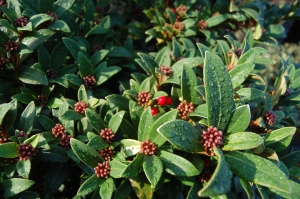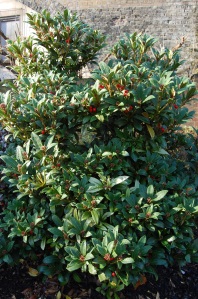Position: Partial shade to full shade
Soil: Moist, well drained, slightly acidic
Flowering period: Mid to late spring
Eventual Height: 1.5m
Eventual Spread: 1.5m
Hardiness: 7a, 7b, 8a, 8b, 9a, 9b
Family: Rutaceae
Skimmia japonica is an evergreen low growing shrub. Its glossy dark green leaves are elliptic with an entire margin and up to 10cm long. Its dioecious flowers buds appear in winter and open in early spring and are mildly fragrant. Female plants will produce bunches of small round red fruit which may persist throughout the year.
Skimmia japonica, commonly known as Skimmia, is native to Japan. It was introduced to England in 1849 by Robert Fortune who discovered it in a nursery near Shanghai. The whole plant however is poisonous, not just the fruit but a large amount must be ingested in order to cause harm. The variety Skimmia japonica subs.reevesiana can self seed and does not require male and female plants.
The etymological root of the binomial name Skimmia is derived from skimmi, the Japanese name for the plant. Japonica is derived from the Latin meaning ‘from Japan’.
The landscape architect may find Skimmia japonica useful as a low growing, evergreen shrub in shady locations, particularly acidic soils. It may also be used as an informal hedge. Once established this plant is drought tolerant.
Ecologically, Skimmia japonica is attractive to various pollinating insects. The berries are attractive to birds.
Skimmia japonica prefers moist, fertile, humus rich, well-drained soils. It tolerates most pH of soil, although it prefers slightly acidic.
Skimmia japonica requires little maintenance. Pruning, if required should be carried out in spring when the new growth is about to start.






One Response to “Skimmia japonica”